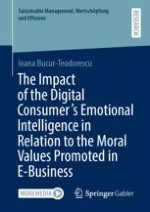2021 | OriginalPaper | Buchkapitel
2. The Role of Moral Values in the Development of E-Business
verfasst von : Ioana Bucur-Teodorescu
Erschienen in: The Impact of the Digital Consumer's Emotional Intelligence in Relation to the Moral Values Promoted in E-Business
Verlag: Springer Fachmedien Wiesbaden
Aktivieren Sie unsere intelligente Suche, um passende Fachinhalte oder Patente zu finden.
Wählen Sie Textabschnitte aus um mit Künstlicher Intelligenz passenden Patente zu finden. powered by
Markieren Sie Textabschnitte, um KI-gestützt weitere passende Inhalte zu finden. powered by
